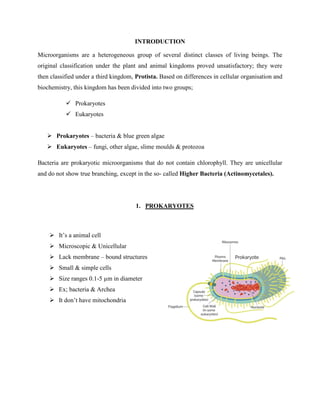general microbiology- prokaryotes vs eukaryotes
•
3 gefällt mir•928 views
definition, features and differences between prokaryotic cell and eukaryotic cell
Melden
Teilen
Melden
Teilen
Downloaden Sie, um offline zu lesen

Empfohlen
Weitere ähnliche Inhalte
Was ist angesagt?
Was ist angesagt? (20)
Cell structure, prokaryotice cell, eukaryotic cell, organization of the cell

Cell structure, prokaryotice cell, eukaryotic cell, organization of the cell
Ähnlich wie general microbiology- prokaryotes vs eukaryotes
Ähnlich wie general microbiology- prokaryotes vs eukaryotes (20)
B.Sc. Biochemistry II Cellular Biochemistry Unit 2 Cellular components

B.Sc. Biochemistry II Cellular Biochemistry Unit 2 Cellular components
Important Notes - NEET - Biology - Cell Structure and Function

Important Notes - NEET - Biology - Cell Structure and Function
Prokaryotes vs. Eukaryotes topic for Senior High School (General Biology 1)

Prokaryotes vs. Eukaryotes topic for Senior High School (General Biology 1)
Analyzing the different organelles in eukaryotic & prokaryotic cells thro...

Analyzing the different organelles in eukaryotic & prokaryotic cells thro...
Mehr von benazeer fathima
Mehr von benazeer fathima (20)
Isolation of antibiotic resistance mutant by replica plating

Isolation of antibiotic resistance mutant by replica plating
Kürzlich hochgeladen
Kürzlich hochgeladen (20)
Labelling Requirements and Label Claims for Dietary Supplements and Recommend...

Labelling Requirements and Label Claims for Dietary Supplements and Recommend...
9654467111 Call Girls In Raj Nagar Delhi Short 1500 Night 6000

9654467111 Call Girls In Raj Nagar Delhi Short 1500 Night 6000
Vip profile Call Girls In Lonavala 9748763073 For Genuine Sex Service At Just...

Vip profile Call Girls In Lonavala 9748763073 For Genuine Sex Service At Just...
VIRUSES structure and classification ppt by Dr.Prince C P

VIRUSES structure and classification ppt by Dr.Prince C P
Recombination DNA Technology (Nucleic Acid Hybridization )

Recombination DNA Technology (Nucleic Acid Hybridization )
Asymmetry in the atmosphere of the ultra-hot Jupiter WASP-76 b

Asymmetry in the atmosphere of the ultra-hot Jupiter WASP-76 b
Disentangling the origin of chemical differences using GHOST

Disentangling the origin of chemical differences using GHOST
Biogenic Sulfur Gases as Biosignatures on Temperate Sub-Neptune Waterworlds

Biogenic Sulfur Gases as Biosignatures on Temperate Sub-Neptune Waterworlds
Botany krishna series 2nd semester Only Mcq type questions

Botany krishna series 2nd semester Only Mcq type questions
Formation of low mass protostars and their circumstellar disks

Formation of low mass protostars and their circumstellar disks
Seismic Method Estimate velocity from seismic data.pptx

Seismic Method Estimate velocity from seismic data.pptx
Creating and Analyzing Definitive Screening Designs

Creating and Analyzing Definitive Screening Designs
Hubble Asteroid Hunter III. Physical properties of newly found asteroids

Hubble Asteroid Hunter III. Physical properties of newly found asteroids
general microbiology- prokaryotes vs eukaryotes
- 1. INTRODUCTION Microorganisms are a heterogeneous group of several distinct classes of living beings. The original classification under the plant and animal kingdoms proved unsatisfactory; they were then classified under a third kingdom, Protista. Based on differences in cellular organisation and biochemistry, this kingdom has been divided into two groups; Prokaryotes Eukaryotes Prokaryotes – bacteria & blue green algae Eukaryotes – fungi, other algae, slime moulds & protozoa Bacteria are prokaryotic microorganisms that do not contain chlorophyll. They are unicellular and do not show true branching, except in the so- called Higher Bacteria (Actinomycetales). 1. PROKARYOTES It’s a animal cell Microscopic & Unicellular Lack membrane – bound structures Small & simple cells Size ranges 0.1-5 µm in diameter Ex; bacteria & Archea It don’t have mitochondria
- 2. Features of Prokaryotic Cell: S.NO FEATURES FUNCTIONS 1. Nucleoid Central region of the cell , which contains it’s DNA 2. Ribosome Helps for protein synthesis 3. Cell wall (CW) It provides structure & protective barrier for cell. most cell wall made from carbohydrates & proteins (peptidoglycans) 4. Cell membrane (CM) Otherwise called as plasma membrane, that separates the cell from the outside environment. 5. Capsule Some bacteria having the layer of carbohydrates surrounded by cell wall (capsule). Helps for attachment on surfaces 6. Fimbriae Thin & hair like structure, helps to cellular attachment 7. Pili Rod shaped structure, involved in attachment & DNA transfer 8. Flagella Thin & tail like structure, helps in movement. 2. EUKARYOTES It’s a plant cell It Have a nucleus Internal organelles are responsible for the variety of functions like energy production and protein synthesis Large and complex cells Multicellular Ex; Animals, Plants, Fungi, Algae And Protozoan’s
- 3. Features of Eukaryotic Cell: S.NO FEATURES FUNCTIONS 1. Nucleus It stores the genetic information in chromatin form 2. Nucleolus Found inside of the nucleus. The place of RNA production 3. Plasma membrane (PM) Is a phospholipids bilayer that surrounds the entire cell and organelles within 4. Cytoskeleton or cell wall (CW) It provides structure and plays an important role in cell movement & division 5. Ribosomes Involved in protein synthesis 6. Mitochondria Also known as power house of the cell, its responsible for energy production 7. Cytoplasm (CP) Region of the cell between nuclear 8. Cytosol Gel like substances within the cell that contains the organelles 9. Endoplasmic reticulum (ER) Helps in protein maturation and transportation 10. Vesicles & vacuoles It’s a membrane bound sacs, involved in transportation and storage Some Differences between Prokaryotic and Eukaryotic Cells: S.No Character Prokaryotic Cells Eukaryotic Cells 1. Nucleus Nuclear membrane - + 2. Nucleolus - + 3. Deoxyribonucleoprotein - + 4. Chromosome One (circular) More than one (linear)
- 4. 5. Mitotic division - + 6. Cytoplasm Cytoplasmic streaming - + 7. Pinocytosis - + 8. Mitochondria - + 9. Lysosomes - + 10. Golgi apparatus - + 11. Endoplasmic reticulum - + 12. Chemical composition Sterols - + 13. Muramic acid + - 14. Membrane bound organelles - + 15. Cell structure Unicellular Multicellular 16. Cell size Smaller (0.1- 5 µm) Larger (10-100 µm) 17. Complexity Simple More complex 18. Examples Bacteria & archea Animals, plants, fungi & protists References: 1. https://www.technologynetworks.com/cell-science/articles/prokaryotes-vs- eukaryotes-what-are-the-key-differences-336095
